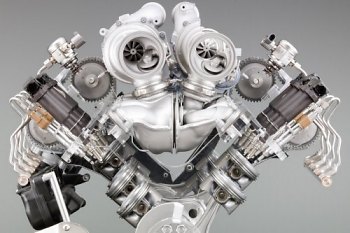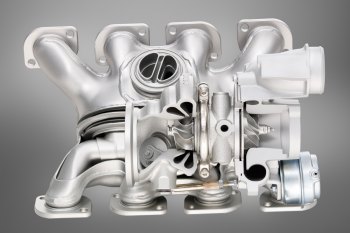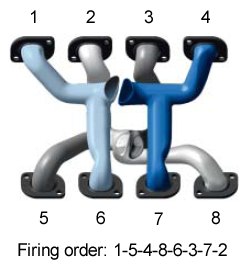|
AUTOZINE TECHNICAL SCHOOL
Turbocharging Twin-scroll turbo
The first time I heard about twin-scroll turbo was in 1989, when the updated Mazda RX-7 Mk2 introduced this feature. It was employed to seperate the exhaust gas from the Wankel engine's two rotors in order to avoid interference. Anyway, twin-scroll turbo is also useful on 4-cylinder and 6-cylinder engines. Mitsubishi, for example, has been using it on its hot Lancer Evo since 1996. Renault used it on the 2.0 turbo engine of Avantime and Megane II Sport in the early 2000s. GM did the same to its 2.8 V6 turbo of Saab 9-3 Aero and Opel Vectra OPC in 2005. Then many manufacturers joined the camp. BMW is perhaps the keenest promoter of the technology. It used twin-scroll turbos on the 1.6-liter Prince engine of Mini (which also benefits countless of Peugeots / Citroens), 2.0-liter four-pot engine, 3.0-liter N55 straight-six and 4.4-liter V8. What makes twin-scroll turbo so attractive? The answer is quicker response and higher efficiency. 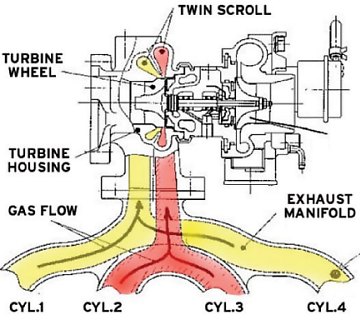 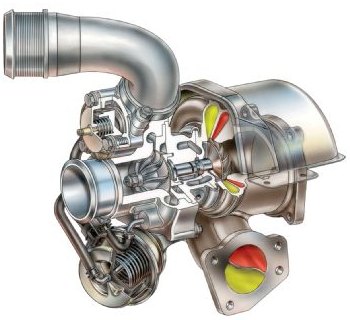 Let's see how it works. While conventional
single-turbo arrangement has all exhaust manifolds connected together
at the exhaust turbine, twin-scroll turbo splits into two separate
paths. For example, in a typical 4-cylinder engine, cylinder 1 and 4
combines to one path, while cylinder 2 and 3 combines to another path.
The two exhaust flows hit the turbine blades independently, as they are
separated by a wall integral with the turbine housing. This prevents
the two exhaust streams to interfere with each other.
But why is the avoidance of interference so important? Please see the following graph. It shows a typical exhaust pulse from one cylinder. When exhaust valves open, the hot exhaust gas rushes out from the combustion chamber and generates a high-pressure pulse. The pulse escapes quickly and pressure drops quickly as well. Tailing the pulse is a negative pressure (lower than atmospheric pressure) period, as we have explained in the Tuned Exhaust section. When the intake valve opens during the "overlap" period, the pressure dips again. Finally, the exhaust valve closed and the pressure in exhaust manifold gets stabilizing. 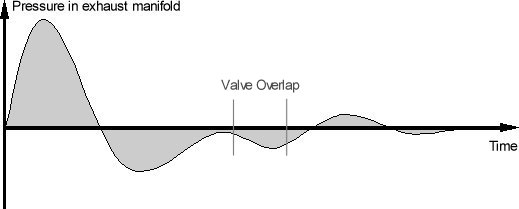 This is only the case of one cylinder. Now
suppose we have a 4-cylinder engine. If we add the exhaust pulses from
all cylinders together, we will find a lot of interferences as below:
 In particular, each positive pulse is partly offset by the negative pressure resulted from the overlap period. Consequently, the strength of the resultant pulse is reduced, and the turbine will take longer time to spool up. Therefore, interference is bad to the response of turbocharger. Now if we use a twin-scroll turbocharger to separate the exhaust gas of Cylinder 1+4 from Cylinder 2+3, we will get two pulse streams with nearly no interferences:   As a result, the pulses are strong and capable to spool up the turbine earlier. Because of the lack of interferences, it allows to use larger valve overlapping that is not possible on single-scroll turbo. Larger valve overlapping results in better scavenging effect - when both inlet and exhaust valves are opened, the exhaust flow helps sucking fresh air into the combustion chamber and driving away the residual exhaust gas. Therefore the combustion chamber is filled with colder, "higher quality" air and benefits volumetric efficiency. Cross-bank turbocharging - BMW
twin-turbo V8 as example
In 2008, BMW launched a new twin-turbo V8 with codename N62. The engine has an unusual intake and exhaust arrangement contrasting to conventional wisdom: the hot exhaust manifolds rest inside the V-valley, while the intake manifolds are located at either sides. This arrangement must have taken its engineers a lot of effort to solve the thermal insulation and cooling problems. It does make the engine more compact, at least in terms of width, if not height. However, the primary reason for the radical change is unlikely to be compactness, but the compatibility with its new cross-bank turbocharging technology. Here we are going to see how it works.
Now we can use the same principles learned from the previous section of Twin-scroll turbo to analyse the engine. If you have not read that section, please read it first. The firing order of a typical V8 engine is 1 - 5 - 4 - 8 - 6 - 3 - 7 - 2. If we combine the exhaust gas of all cylinders together, we will get a pulse train as below. It shows a lot of interference. Each pulse is partly offset by the negative tails of the preceding pulses. This reduces the strength of the resultant pulse thus hampers turbo response.  Of course, we won't equip a V8 engine with a single turbocharger, so the above graph is unrealistic. A fair comparison should be made to a conventional twin-turbo arrangement. In that case, Cylinder 1, 2, 3 and 4 connects to the same turbocharger. The resultant pulse train is as below:  Now we can see two problems: 1) There are still quite a lot of interferences between pulse 1 and 4, pulse 3 and 2, as well as pulse 2 and 1. Only pulse 3 and 4 are widely spaced enough to prevent from interference. As a result, the strength of resultant pulses is reduced. 2) The intervals between pulses are not constant, i.e. 180º - 270º - 180º - 90º. In other words, the pulse train does not run at a constant frequency. This does not help speeding up the turbine. Apparently, to achieve a constant flow of exhaust stream, the turbo cannot rely on cylinders of the same bank. That's why the cross-bank concept gets into the picture. Consider BMW's arrangement with cylinder 1, 4, 6 and 7 connected together, we get the following pulse stream:  It has a constant frequency, but the interference is still too much, or actually the same as a conventional four-cylinder engine. Like the latter, we can use twin-scroll turbos to solve the problem. By splitting the exhaust gas into two groups, i.e. Cylinder 1+6 and Cylinder 4+7, we get:  The result becomes perfect ! with a constant frequency and nearly no interference to speak of ! No wonder the BMW cross-bank turbocharged V8 is renowned for good low-end response and high efficiency. Take the version on M5 for example, it produces 560 hp and 501 lbft of torque from 4.4 liters, and the peak torque is available from as low as 1500 rpm all the way to 5750 rpm. Such a combination of high specific power and broad spread of torque is unprecedented. Thanks must go to the cross-bank turbocharging. |
||||||||

|
||||||||
| Copyright© 1997-2011 by Mark Wan @ AutoZine |
